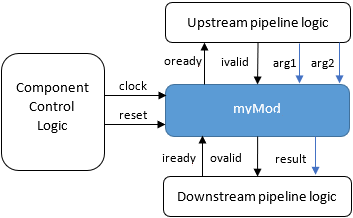Intel® High Level Synthesis Compiler Pro Edition: Reference Manual
A newer version of this document is available. Customers should click here to go to the newest version.
11.4.1.2. RTL Module Interfaces
For an RTL module to properly interact with other compiler-generated operations, you must support a simple ready/valid handshaking protocol at both the input and the output of an RTL module.
An RTL module must use a single streaming interface. That is, a single pair of ready and valid logic must control all the inputs.
You have the option to provide the necessary streaming ports but declare the RTL module as stall-free. In this case, you do not have to implement proper stall behavior because the Intel® HLS Compiler creates a wrapper for your module.
You must handle ivalid signals properly if your RTL module has an internal state. For more information, see Stall-Free RTL.
Consider the following interfaces for the RTL module myMod:

In this diagram, myMod interacts with the upstream module through data signals, arg1 and arg2, and control signals, ivalid (input) and oready (output). The ivalid control signal equals 1 (ivalid = 1) if and only if data signal arg1 and data signal arg2 contain valid data. When the control signal oready equals 1 (oready = 1), it indicates that the myMod RTL module can process the data signals arg1 and arg2 if they are valid (that is, ivalid = 1). When ivalid = 1 and oready = 0, the upstream module holds the values of ivalid, arg1, and arg2 in the next clock cycle.
The myMod module interacts with the downstream pipeline logic through the data signal result and the control signals, ovalid (output) and iready (input). The ovalid control signal equals 1 (ovalid = 1) if and only if the data signal result contains valid data. When the iready control signal equals 1 (ivalid = 1), the downstream module can process the data signal result if it is valid. When ovalid = 1 and iready = 0, the myMod RTL module must hold the valid of the ovalid and result signals in the next clock cycle.